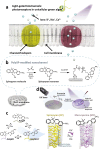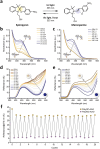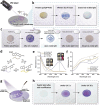Illuminating Biomimetic Nanochannels: Unveiling Macroscopic Anticounterfeiting and Photoswitchable Ion Conductivity via Polymer Tailoring
- PMID: 39302690
- PMCID: PMC11447919
- DOI: 10.1021/acsnano.4c08801
Illuminating Biomimetic Nanochannels: Unveiling Macroscopic Anticounterfeiting and Photoswitchable Ion Conductivity via Polymer Tailoring
Abstract
Artificial photomodulated channels represent a significant advancement toward practical photogated systems because of their remote noncontact stimulation. Ion transport behaviors in artificial photomodulated channels, however, still require further investigation, especially in multiple nanochannels that closely resemble biological structures. Herein, we present the design and development of photoswitchable ion nanochannels inspired by natural channelrhodopsins (ChRs), utilizing photoresponsive polymers grafted anodic aluminum oxide (AAO) membranes. Our approach integrates spiropyran (SP) as photoresponsive molecules into nanochannels through surface-initiated atom transfer radical polymerization (SI-ATRP), creating a responsive system that modulates ionic conductivity and hydrophilicity in response to light stimuli. A key design feature is the reversible ring-opening photoisomerization of spiropyran groups under UV irradiation. This transformation, observable at the molecular level and macroscopically, allows the surface inside the nanochannels to switch between hydrophobic and hydrophilic states, thus efficiently modulating ion transport via changing water wetting behaviors. The patternable and erasable polySP-grafted AAO, based on a controllable and reversible photochromic effect, also shows potential applications in anticounterfeiting. This study pioneers achieving macroscopic anticounterfeiting and photoinduced photoswitching through reversible surface chemistry and expands the application of polymer-grafted structures in multiple nanochannels.
Keywords: anodic aluminum oxide; anticounterfeiting; biological nanochannel; ion conductivity; photoswitchable; spiropyran.
Conflict of interest statement
The authors declare no competing financial interest.
Figures






References
-
- Wang F.; Cui A.; Hu Z.; Zhang L. Photogated Coordination Switching of Silver Nanoparticles for Reversible Coloration/Discoloration of Hydrogel. Adv. Opt. Mater. 2021, 9, 210150510.1002/adom.202101505. - DOI
LinkOut - more resources
Full Text Sources

